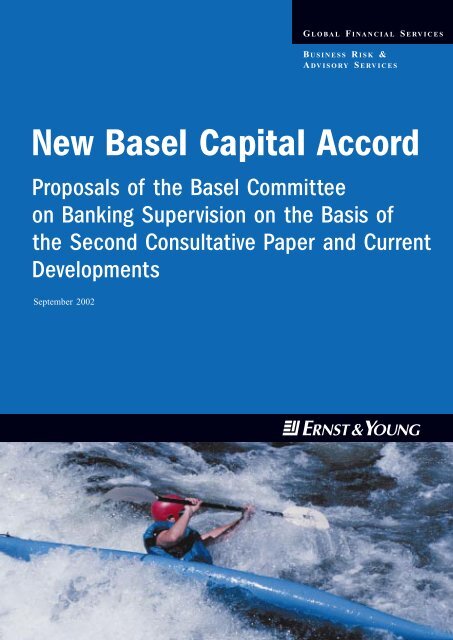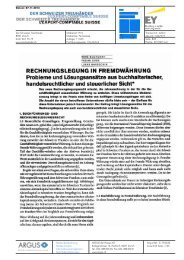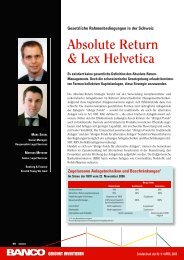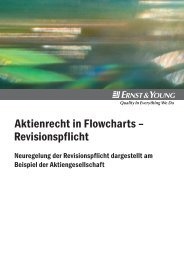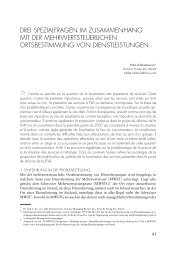New Basel Capital Accord
New Basel Capital Accord
New Basel Capital Accord
- No tags were found...
You also want an ePaper? Increase the reach of your titles
YUMPU automatically turns print PDFs into web optimized ePapers that Google loves.
G LOBAL F INANCIAL S ERVICESB USINESS R ISK &A DVISORY S ERVICES<strong>New</strong> <strong>Basel</strong> <strong>Capital</strong> <strong>Accord</strong>Proposals of the <strong>Basel</strong> Committeeon Banking Supervision on the Basis ofthe Second Consultative Paper and CurrentDevelopmentsSeptember 2002
GERMAN INVESTMENT FUNDSImprintErnst & Young AGWirtschaftsprüfungsgesellschaftGlobal Financial ServicesBusiness Risk & Advisory ServicesEschersheimer Landstraße 1460322 Frankfurt am MainEditorial:Michael Laupenmühlen, Rudolf MoschitzThe address of our "<strong>Basel</strong> II" Center of Competence as well as the address forordering additional copies of this brochure can be found on page 22.Last updated: September 2002Ernst & Young will inform you of further developments in the next edition whichis planned for spring 2003.Up-to-date information on the <strong>New</strong> <strong>Basel</strong> <strong>Capital</strong> <strong>Accord</strong> can also be found on theinternet at www.bis.org.2 ERNST & YOUNG – NEW BASEL CAPITAL ACCORD
Table of ContentsPageThe Effects of the <strong>New</strong> <strong>Basel</strong> <strong>Capital</strong> <strong>Accord</strong> 4<strong>Basel</strong> as the Forerunner of Supervisory Harmonization 6<strong>Basel</strong> Milestones 7Future Scope of Application of the <strong>New</strong> <strong>Basel</strong> <strong>Capital</strong> <strong>Accord</strong> 10Effects of the <strong>New</strong> <strong>Basel</strong> <strong>Capital</strong> <strong>Accord</strong> on the Norms of Other Standard-Setters 11The Three Pillars of the <strong>New</strong>, Extended <strong>Basel</strong> Plans on Supervision 12The Conceptual Environment of Risk-Adequate <strong>Capital</strong> Charges 13Specific <strong>Capital</strong> Treatment of Credit Risk in Pillar 1 14Separate Quantification of Operational Risk 16Requirements on Risk Management From Pillar 2 18Pillar 3 Calls for Public Disclosure Under Banking Supervision 20Bibliography 21Your Gateway to Our "<strong>Basel</strong> II” Center of Competence 22ERNST & YOUNG – NEW BASEL CAPITAL ACCORD3
The Effects of the <strong>New</strong> <strong>Basel</strong> <strong>Capital</strong> <strong>Accord</strong>"A revolution in banking supervision" that will have a lastingeffect on the business structure of banks - that is how JochenSanio, President of the German Federal Financial SupervisoryAgency (BAFin) has referred to the <strong>Basel</strong> plans for therevision of capital requirements.A leading banking industry expert has described the practicalaspects of <strong>Basel</strong> II for banks even more succinctly, "The worldwill be a changed place once the <strong>New</strong> <strong>Accord</strong> comes intoeffect".For the first time, the <strong>New</strong> <strong>Basel</strong> <strong>Capital</strong><strong>Accord</strong> (<strong>Basel</strong> II) will not onlyaffect internationally active bankinggroups but will also find its way intoGerman banking regulations throughrapid integration in the banking supervisoryregulations of the EuropeanUnion, and thus become the mandatorystandard for all banks.The current delay in the timetable is noreason to sit back and relax. On the contrary,the complexity of the subject andthe high number of comments receivedup to May 2001 (over 250) on the secondConsultative Paper on the amendmentof the <strong>Basel</strong> capital proposals hasmanaged to convince the <strong>Basel</strong> Committeeon Banking Supervision to performa third empirical study (QuantitativeImpact Study – QIS) prior to adoptionand allow a third consultationperiod. Although this means that thecall for "quality over time schedule" haswon, we cannot sit back and wait. Theneed is too great to revise the <strong>Basel</strong> regulationsfrom 1988 which are no longerrisk adequate, and the administrativepreparations for implementation inbanks are too significant and far-reaching.The BAFin President neatly sumsJuly 1988January 1996 June 1999 January 2001 October 2002 – February 2003 May 2003 October 2003 January 2006 January 2007Introductionof <strong>Basel</strong> IAddition ofMarket RiskFirstConsultativePaper on<strong>Basel</strong> IISecondConsultativePaper on<strong>Basel</strong> IIThird Quantitative Impact StudyThirdConsultativePaper on<strong>Basel</strong> IIAdoption of<strong>Basel</strong> IIParallelcalculationpursuant to<strong>Basel</strong> I and II<strong>Basel</strong> IIcomes intoeffectup the situation, "Each day of inactivitythat passes is a day lost".The empirical results now availableshow that the groundwork for the definitionof future capital requirementshas to a large extent been laid. TheThird Quantitative Impact Study and theThird Consultative Paper are generallyexpected to be followed by little more4 ERNST & YOUNG – NEW BASEL CAPITAL ACCORD
THE EFFECTS OF THE NEW BASEL CAPITAL ACCORDthan fine tuning. After commencementof the QIS 3 in October 2002, resultsare anticipated early in 2003. It isplanned to present the Third ConsultativePaper in May 2003. At the moment,<strong>Basel</strong> II is expected to be adopted atthe end of October 2003. Entry intoforce of the <strong>New</strong> <strong>Capital</strong> <strong>Accord</strong> isscheduled for the beginning of 2007,however parallel reporting will be performedpursuant to <strong>Basel</strong> I and <strong>Basel</strong>II from January 2006. Early applicationof <strong>Basel</strong> II is solely intended forbanking supervisory authorities. Reportingpursuant to <strong>Basel</strong> I will remain thenorm during this transitional phase.Common to all modern measurementapproaches is that they are based onthe individual bank’s risk-related datarather than on general regulations andthus allow an approximation of regulatorymeasurement to the bank’s internalrisk and performance management. Forthe application of the more risk-specificapproaches, certain economicallyplausible incentives are defined whichgenerally result in lower capitalrequirements than the more generalrules. This general tendency does notnecessarily apply to every single case,nonetheless, and an individual analysisis therefore advisable. Internal ratingsrequired for the purposes of modernapproaches in lending activities and forindividual approaches for the identificationand quantification of operationalrisk require historical data andstatistics to be kept. Since in the majorityof cases at least three years of historicaldata must be available, urgentaction is required from 2002.Weighted and Accumulated Probability of Occurence 1970-2000Business reality, on the other hand, hasalready taken hold as banks will have achoice from a range of measurementapproaches to set capital charges forcredit risk and operational risk, and thechoice will result in varying capitalrequirements. Which approach is mostadvantageous for an individual bankdepends on the bank’s specific circumstances;these should be carefullyreviewed before a decision is made.Probability of DefaultRatingProbability of Default for Rating CategoriesYearsERNST & YOUNG – NEW BASEL CAPITAL ACCORD5
GERMAN INVESTMENT FUNDS<strong>Basel</strong> as the Forerunner of Supervisory HarmonizationWhen the <strong>Basel</strong> Committee was establishedin 1974 by the central bankGovernors of the Group of Ten countries1 and Luxembourg under the nameof "Committee on Banking Regulationsand Supervisory Practices", there wasneither a comparable internationalbanking supervisory body at individualinstitute level nor group-wide regulationfor banking groups. Apart fromthe First Banking Law CoordinationDirective from the European Union, allother EU directives on the harmonizationof banking supervision were notpassed until the 1980s and 1990s.The work of the Committee whose meetingsare usually held at the Bank forInternational Settlements (BIS) focuseson two major objectives: firstly, tocreate a framework to strengthen thesoundness and stability of the internationalbanking system. Secondly, tomake that framework fair and consistentin its application to banks in differentcountries in order to reduce the distortionof competition between internationalbanks.In order to realize these objectives,which are welcomed by the bankingindustry on the whole, the Committeein <strong>Basel</strong> and the authorities of the EuropeanUnion (EU) in Brussels conferredclosely on later work in order to harmonizeas far as possible the rules agreedin <strong>Basel</strong> and the plans of the EU.Nevertheless the current <strong>Basel</strong> rules andthe EU rules implemented in Germanyin Principle I still differ in a number ofrespects. For example, commercial mortgageloans or securities backed by mortgagesare currently still recognized 100%in the BIS capital ratio whereas PrincipleI allows reduced risk-weighting of50%.NorthAmericaEuropeAsiaAmong the supervisors from the individualcountries on the <strong>Basel</strong> Committee,the Federal Republic of Germany isrepresented by both the GermanFederal Central Bank (Bundesbank)and the Federal Financial SupervisoryAgency (BAFin).SouthAmericaAfrica1US, Canada, Germany, France, United Kingdom,Italy, Japan, Netherlands, Sweden, Belgium,Switzerland.6ERNST & YOUNG – NEW BASEL CAPITAL ACCORD
<strong>Basel</strong> Milestones1974<strong>Basel</strong> as the Forerunner ofConsolidated Supervision1975<strong>Basel</strong> Concordat on theCooperation of Regulators1988<strong>Basel</strong> <strong>Capital</strong> <strong>Accord</strong>(<strong>Basel</strong> I)The original task of the <strong>Basel</strong> Committee on Banking Supervision which was foundedin 1974, was the formulation of principles which would close gaps in thesupervision of international banking groups. The concept of ConsolidatedSupervision, which is still the sole basis of the <strong>Basel</strong> recommendations today, wasnew at the time. Up until the 1980s the German Banking Act (KWG) was limitedto supervision of individual banks, while consolidated supervision was notintroduced until the Third KWG Amendment in 1984, a decade after <strong>Basel</strong>.The first visible result of the Committee’s work was the <strong>Basel</strong> Concordat of 1975regulating international cooperation between supervisory authorities. The aimof this recommendation, which was revised in 1983, is the comprehensive, crossbordersupervision of banks both in their country of origin and in all of theirforeign branches.The "Minimum Requirements for <strong>Capital</strong> Adequacy of Internationally ActiveBanks" agreed in 1988 have proved to be the most significant milestone so far.Initially intended for internationally active banks in the Group of Ten countries,the widespread acceptance of this norm led to it gradually becoming the recognizedstandard in over 100 countries.Above all, this recommendation now referred to as "<strong>Basel</strong> I" set important internationalstandards in three ways: firstly, despite hefty differences of opinion, therecognition of the constituents of capital was largely harmonized – since thencapital has been sub-divided into core capital (Tier 1) and supplementary capital(Tier 2). Secondly, risk rates for exposures were set. The framework of weightsis considered to be too broad by today’s standards and is the main reason for theamendment; the framework was also methodically limited by data processing andrisk measurement capabilities available at the time. Thirdly, the important minimumratios for Tier 1 capital (4% of weighted exposures) and total capital (8%of weighted exposures) were set. These ratios are also frequently known as theBIS Tier 1 <strong>Capital</strong> Ratio or the BIS <strong>Capital</strong> Ratio after the seat of the <strong>Basel</strong>Committee at the Bank for International Settlements (BIS).ERNST & YOUNG – NEW BASEL CAPITAL ACCORD7
BASEL MILESTONES1996Inclusion of Market RiskFrom the mid 1990sA Broader Range ofSupervisory TopicsIn view of the strong growth in derivatives and trading activities at banks, the <strong>Basel</strong>recommendation, which originally focused on country and credit risk, was extendedat the beginning of 1996 to include market risk. Recognition for the firsttime of the internal model which had established itself on the market as a basisfor supervisory purposes was a milestone in methodology.Alongside continually developing the capital requirements, the <strong>Basel</strong> Committeehas also increasingly dedicated itself to other bank-related subjects since 1995.As a result, a series of other supervision-relevant consultative papers and recommendationshave been published, partly in cooperation with the International Organizationof Securities Commissions (IOSCO).1995/1998 "Framework for Supervisory Information About the Derivatives Activities of Banks andSecurities Firms"1995/1999 "Survey of Disclosures About Trading and Derivatives Activities of Banks and Securities Firms"1997/1999 "Core Principles for Effective Banking Supervision"1998/1998 "Framework for the Evaluation of Internal Control Systems"1998 "Progress Report Reducing Foreign Exchange Settlement Risk""Operational Risk Management""Enhancing Bank Transparency""Sound Practices for Loan Accounting, Credit Risk Disclosure and Related Matters"1999/2000 "Sound Practices for Banks’ Interactions With Highly Leveraged Institutions"1999 "Recommendations for Public Disclosure of Trading and Derivatives Activities of Banks andSecurities Firms""Principles for the Management of Credit Risk""Managing Settlement Risk in Foreign Exchange Transactions""Enhancing Corporate Governance for Banking Organizations"2000 "Sound Practises for Managing Liquidity in Banking Organizations""Internal Audit in Banking Organizations and the Relationship of the SupervisoryAuthorities With Internal and External Auditors"2001 "Customer Due Diligence for Banks"June 1999First Consultative Paperon the <strong>Capital</strong> <strong>Accord</strong>In response to criticism that the risk weights in the 1988 <strong>Basel</strong> <strong>Capital</strong> <strong>Accord</strong> didnot adequately reflect the actual risk of the positions held by banks, the First ConsultativePaper "A <strong>New</strong> <strong>Capital</strong> Adequacy Framework" was published to replace<strong>Basel</strong> I in June 1999. All interested institutions were requested to submit commentsby March 31, 2000 on this framework for a more risk-oriented revision ofthe 1988 <strong>Capital</strong> <strong>Accord</strong>. The <strong>New</strong> <strong>Capital</strong> Adequacy Framework has sincebecome known as the <strong>New</strong> <strong>Basel</strong> <strong>Capital</strong> <strong>Accord</strong> or "<strong>Basel</strong> II".8ERNST & YOUNG – NEW BASEL CAPITAL ACCORD
BASEL MILESTONESJanuary 2001/May 2003Second and ThirdConsultative PapersFollowing evaluation and revision, a Second Consultative Paper was publishedon January 16, 2001 with a deadline for comments of May 31, 2001. This proposedfor the first time the application of internal rating procedures to set capitalcharges for credit risk. The unsatisfactory and disappointing results of theQuantitative Impact Studies (QIS I and in particular QIS 2), the magnitude of theunresolved areas of regulation and not least the high quality of the comments receivedprompted the <strong>Basel</strong> Committee to propose a third consultation roundwhich had been categorically rejected in January 2001. The Third QuantitativeImpact Study (QIS 3) has been running since October 1, 2002 and will form thebasis for the Third Consultative Paper expected in May 2003. The period for thesubmission of comments will be 90 days. The EU Commission is also expectedto publish its Third <strong>Capital</strong> Adequacy Directive in May 2003.October 2003/2006 and BeyondAdoption and Other PlansThe timetable for the adoption of <strong>Basel</strong> II has been postponed to October 31,2003. The European Commission will publish a draft capital directive in early2004. The final capital directive should be adopted on December 31, 2005 andthen implemented in national law within a year. <strong>Basel</strong> II is to come into effect atthe beginning of 2007, however – as far as is currently known – banks must performparallel reporting to the BAFin pursuant to <strong>Basel</strong> I and <strong>Basel</strong> II from January2006. Reporting pursuant to <strong>Basel</strong> I will remain the norm during this transitionalphase, however.Further plans, which include revising the definition of capital and the credit riskmodel for setting capital charges, will be realized in the <strong>Basel</strong> III and <strong>Basel</strong> IVamendments after adoption of <strong>Basel</strong> II.ERNST & YOUNG – NEW BASEL CAPITAL ACCORD9
Future Scope of Application of The <strong>New</strong> <strong>Basel</strong> <strong>Capital</strong> <strong>Accord</strong><strong>Basel</strong> I Aimed at International BanksBuilding on the objective of strengtheningthe soundness and stability ofthe international banking system, thepreamble to the First <strong>Basel</strong> <strong>Capital</strong><strong>Accord</strong> adopted in 1988 – and referredto today as <strong>Basel</strong> I – states that the"Committee’s framework is directedmore specifically with banks undertakinginternational business in mind".It is also stressed here, however, that the<strong>Basel</strong> framework is designed to establishminimum levels of capital and "nationalauthorities will be free to adoptarrangements that set higher levels". 1Extension of the Scope of Applicationof <strong>Basel</strong> IIInstead of focusing as previously oninternationally active banks, <strong>Basel</strong> II isnow aimed at all "major banks andsimilar financial institutions". <strong>Basel</strong> IIhas thus moved away from being a standardfor international activity to becominga standard which characterizes thebank’s position in the market. Hence<strong>Basel</strong> II also deals with banks which are"only" active on the domestic market.Financial institutions and holdingcompanies of banking groups are nowalso included in the scope of application.This means that, in terms of thefield of activity, an approximation of thescope of supervision of the EU <strong>Capital</strong>Adequacy Directive 2 adopted in 1993and the EU Directive on InvestmentServices in the Securities Field 3 hasbeen achieved. The latter extension inscope does not step up supervision inGermany, however, as this area isalready covered by the provisions of theGerman Banking Act (KWG).In addition to the institutions explicitlyaddressed in <strong>Basel</strong> II, the <strong>Basel</strong> amendmentwill also indirectly affect all otherinstitutions as the EU Commission isplanning to incorporate the future <strong>Basel</strong>capital requirements into an EU provisionpossibly word for word. This EUprovision would then have to be implementedinto national law (in Germanyin the KWG and in Principle 1 of theBAFin which expands on Secs. 10 and10a KWG) and would, therefore, applyto all banks in Germany, regardless oftheir size, instead of only the 14 Germanbanks originally affected. To speedup implementation, use of the legislativeprocedure of comitologie initiatedby Baron Alexandre Lamfalussy is alsobeing considered, i.e. the European Parliamentand the EU governments definethe basic regulatory framework withthe detailed regulations being dealt withby a committee of government representativeschaired by the Commission.The Focus Remains on Groups in<strong>Basel</strong> IIAs with the original <strong>Basel</strong> <strong>Capital</strong><strong>Accord</strong>, <strong>Basel</strong> II will also apply on agroup level. With regard to subsidiariesand subordinated companies, the scopeof application will be limited to companiesoperating in the banking andfinancial sector. This definition of theconsolidated group, which differs fromthe concept used in accounting, is in linewith supervisory practice under theKWG. In contrast to the KWG, whosecapital requirements apply both to individualinstitutions and groups, <strong>Basel</strong> continuesto relate to groups exclusively.1Cf. <strong>Basel</strong> Committee on Banking Regulations andSupervisory Practices: International Convergence of<strong>Capital</strong> Measurement and <strong>Capital</strong> Standards, July1986, p. 42Directive 93/6/EEC, Official Journal L141/1 of theEU dated June 11, 19933Directive 93/22/EEC, Official Journal L141/27 ofthe EU dated June 11, 199310 ERNST & YOUNG – NEW BASEL CAPITAL ACCORD
Effects of the <strong>New</strong> <strong>Basel</strong> <strong>Capital</strong> <strong>Accord</strong> on the Norms of Other Standard-SettersThe increasingly international flow ofmoney has meant that, since the 1970sat the latest, developments in bankingsupervision have no longer been characterizedby the isolated actions ofnational supervisory committees.Instead, more or less synchronous reactionsof a series of standard-setters tocertain specific changes in the marketscan increasingly be observed.It is not only quasi governmental supervisorycommittees that are active in standard-settingbut also, to a considerableextent, the market players themselveswho are trying to establish standards forthe appropriate treatment of newactivities and the management ofensuing risks in cross-institution andeven cross-border working groups. Thefollowing recommendations of the Associationof German Banks (BdB) onbalance sheet disclosures on derivativesactivities and market risk are an exampleof a typical case of self-regulationin the area of accounting and have becomethe standard for transparency inreporting:First and foremost, however, it is thesupervisory committees of state institutionsthat are responsible for definingsuitable regulatory procedures to combatrisks arising from developments onthe financial markets in order to ensurethe soundness and stability of thefinancial system.Due to the fact that innovations in thefinancial industry can be rapidly reproduced,the global and increasingly fastspread of new ideas means that numerouscommittees are dealing with almostidentical subjects. To some extent thework of committees is interlinked –often the same people are working onthe same issues on different committees.Nonetheless, diverging interests canresult in different regulations. Overall,however, standard-setters are endeavoringto harmonize regulations.<strong>Basel</strong> developments in capital requirementsnaturally have a strong influenceon the progress of harmonizationin banking legislation in the EU. Givenpast experience of long-winded agreementprocesses prior to adoption of anEU directive and the subsequent nationalimplementation, the plan of the EUCommission to incorporate the future<strong>Basel</strong> capital requirements word forword in an EU provision should speedup the process considerably. After therecent publication of the EU Commission’sSecond Consultative Paper, BAFinwelcomed the fact that due to the closetiming of the publication with the second<strong>Basel</strong> Paper, competitive equalitybetween the European banking industryand non-European institutions will bemaintained.Balance Sheet Disclosure of Financial Derivatives – Recommendations of the Accounts Committee of the Association of GermanBanks for Reporting on Transactions With Financial Derivatives in the Framework of Banks’ Financial Reporting.Disclosure of Market Risk – Recommendations of the Accounts Committee of the Association of German Banks on the Disclosureof Quantitative Information on Market Risk Potential in Annual Reports.Balance Sheet Recognition and Disclosure of Credit Derivatives – Comments, Assessments and Recommendations of theAccounts Committee of the Association of German Banks.ERNST & YOUNG – NEW BASEL CAPITAL ACCORD11
The Three Pillars of the <strong>New</strong>, Extended <strong>Basel</strong> Plans on SupervisionThe main objective of the revision ofthe <strong>Basel</strong> <strong>Capital</strong> <strong>Accord</strong> of 1988, a stepwhich is welcomed by the banking industry,is the setting-up of more riskorientedcapital charges for credit,market and operational risk. Not onlywill the edge be taken off "creativesupervisory arbitrage" with a morerealistic relationship between the actualrisk and the required capital charges, butmore efficient capital allocation willalso be achieved which will permitpricing policy to reflect actual risk.The present supervisory instruments ofthe <strong>Basel</strong> <strong>Capital</strong> <strong>Accord</strong> of 1988 andthe addition made in 1996 of equitybacking for market price risk, are mainlybased on quantitative ratings and havebeen preserved in Pillar 1. The measurementprocess for credit risk has beenrefined, however, and operational riskhas been added to the risks to be explicitlybacked by capital. Hence inPillar 1, operational risk in addition tocredit and market risk will have to beseparately quantified and covered bycapital. These are supplemented byPillars 2 and 3, which describe regulationson the "Supervisory ReviewProcess" and "Market Discipline andDisclosure".In future, the <strong>New</strong> <strong>Capital</strong> <strong>Accord</strong> willbe founded on the following threepillars:- Pillar 1: Minimum <strong>Capital</strong>Requirements- Pillar 2: Supervisory ReviewProcess- Pillar 3: Market Discipline andDisclosureStability of the Banking SystemPillar 1Minimum<strong>Capital</strong>RequirementsPillar 2SupervisoryReviewProcessPillar 3Market DisciplineandDisclosure<strong>New</strong> <strong>Basel</strong> <strong>Capital</strong> <strong>Accord</strong> (“<strong>Basel</strong> II”)12 ERNST & YOUNG – NEW BASEL CAPITAL ACCORD
The Conceptual Environment of Risk-Adequate <strong>Capital</strong> Charges<strong>Capital</strong>, whose importance has alwaysbeen emphasized in the banking industrydue to the sensitivity of the business,has gained considerably in significancedue to increasing pressure ofcompetition and sinking margins. Therecognition that capital, that "rare commodity",is now the decisive bottleneckfactor in opportunities for business developmenthas allowed the allocation ofequity to become a central element ofbank-wide management.In addition to general allocation assumptions,risk exposure must be taken intoaccount in the risk/return assessmentin order to adequately measure the efficiencyof capital employed. While internalaccounting in banks has made progressin methodology in this area in thelast decade and has become the inalienablecore of business management in theform of management accounting, financialreporting and supervisory standardshave both been unable to keep pace witheconomic reality.IAS 30/32On an international level, the work of theInternational Accounting StandardsBoard is becoming increasingly important.On the subject of cross-industryregulations, IAS 32 "Financial Instruments:Disclosure and Presentation"contains reporting requirements for risksassociated with financial instruments.This Standard distinguishes between fourtypes of risk: price, credit, liquidity andcash flow risk. Contrary to GAS 5-10(German Accounting Standard), IAS 32leaves it up to the preparer to decidewhether risks are disclosed verbally orthrough quantitative information. Moreover,more detailed requirements for riskreporting resulting from the planned revisionof IAS 30, "Disclosures in the FinancialStatements of Banks and SimilarFinancial Institutions" are expected to beindustry specific.ERNST & YOUNG – NEW BASEL CAPITAL ACCORD13
Specific <strong>Capital</strong> Treatment of Credit Risk in Pillar 1In future, banks will be able to choosebetween three different methods ofcalculating capital charges for creditrisk: Standardized Approach, FoundationIRB Approach and Advanced IRBApproach. Based on <strong>Basel</strong> I in its methodology,the Standardized Approach usesratings from external rating agencies toset capital charges, while both internalrisk-based (IRB) approaches rely on thebank’s internal rating processes (todetermine risk weights).The choice of approach has a directinfluence on the level of capital chargesrequired.Standardized ApproachConsistent with the current approach,the Standardized Approach defines certainrisk weights for individual categoriesof credit exposures. Numerically,the current weighting rates 0%, 20%,50% and 100% will remain, with theaddition of a new weighting of 150%for higher-risk borrowers. To a largerextent than to date, banking supervisionwill recognize the securitizationinstruments used by banks, such ascollateral, guarantees, credit derivativesand netting agreements for on-balancesheet items. For the current risk groupsof sovereigns, banks and non-banks, riskweighting will mainly depend on theassessment of external rating institutionsor rating agencies. The respectivenational banking supervisory authoritiesare to review which agencies’ ratings forsupervisory risk weighting may be used.Claims on sovereigns will be weightedbetween 0% and 150% depending ontheir rating. Public sector claims in Germanywill continue to be weighted at0% in the Standardized Approach.Claims on non-central governmentpublic sector enterprises (PSEs) are tobe weighted as claims on banks. However,countries will have the right tochoose to treat them as sovereigns, suchthat the practice in Germany of 0%weighting for federal states and certainspecial funds may be retained.For claims on banks, <strong>Basel</strong> II proposesa right for national supervisors tochoose between two options. In the firstoption, the risk weighting will be directlylinked to the rating of the countrywhere the bank has its seat and then setone category higher. In the secondoption, the bank’s risk weighting will bedirectly determined by an externalrating.For claims on corporates, three newrisk weighting classes of 20%, 50% and150% will be introduced, dependent onexternal ratings, in addition to thecurrent weighting of 100%. As at present,claims will be weighted at 100%if an external rating is not available.Calculationof Credit RiskStandardizedApproachFoundationIRB ApproachAdvancedIRB Approach14 ERNST & YOUNG – NEW BASEL CAPITAL ACCORD
SPECIFIC CAPITAL TREATMENT OF CREDIT RISK IN PILLAR 1Ernst & Young offers you competent, comprehensiveassistance in the development andimplementation of the new Pillar 1 capitalrequirements in your institution, taking fullaccount of the relevant supervisory framework.Foundation Internal RatingApproachWith the recognition of internal ratings,it will for the first time be possible touse banks’ own management and riskmeasurement methods to calculate thecapital charges for credit risk. In orderto achieve widespread application of theIRB Approach, the measurementmethods for quantitative risk componentsare restricted in the FoundationIRB Approach, in contrast to the AdvancedIRB Approach, to the probabilityof default (PD) in individual riskexposure classes. The other risk components,however, are prescribed.Collateral, credit derivatives and nettingagreements are taken into account in theresult as in the Standardized Approach.Advanced Internal RatingApproachIn the Advanced IRB Approach, banksalso have the option to apply their internallyestimated parameters to otherrisk components, with the exception ofresidual maturity. Thus in this model,which is more complex than the FoundationApproach, expected loss (EL) atthe time of default as well as expectedamount of claim at the time of default,for example, can be calculated specificallyfor each bank on the basis of thebank’s historical realized loss rates.Additionally, the range of eligible collateralis less restricted.Banks have to adhere to qualitative minimumrequirements to be able to use theAdvanced IRB Approach, however.Certain qualifying criteria shouldensure that the rating system and ratingprocess as well as risk components areadequate for each bank.Partial Use of the IRB Approach fora Limited PeriodFor a limited, transitional period bankswill be allowed to apply the IRBApproach to just a share of exposures.At the same time, however, the scopeand timing of partial use must beagreed with the supervisory authorityuntil full conversion to the IRBApproach in order to avoid the best alternativebeing "cherry picked" each time.ERNST & YOUNG – NEW BASEL CAPITAL ACCORD15
Separate Quantification of Operational RiskUntil now, the process of quantifying therisks to be covered by capital has onlyincluded separate calculations for creditrisk and market risk, with operational riskbeing absorbed by a blanket capitalcharge that was generally too high. Infuture, operational risk will also haveto be separately quantified andcovered by capital. The <strong>Basel</strong> Committeedefines operational risk as "the riskof direct or indirect loss resulting frominadequate or failed internal processes,people and systems or from externalevents".There are also three ways of calculatingthe capital charge for operational risk.Developments subsequent to the SecondConsultative Paper have resulted in bankshaving a choice between the followingapproaches to the capital assessment ofoperational risk: the Basic IndicatorApproach, which applies to the wholebank, the Standardized Approach,which differentiates between businesslines and the Advanced MeasurementApproaches. Advanced MeasurementApproaches will give banks the opportunityto use loss distribution and scorecardapproaches in addition to the InternalMeasurement Approach in calculatingthe capital charge.The simplicity of the Basic IndicatorApproach, which sets the capitalrequirement for operational risk at a fixedpercentage of a bank’s gross income,speaks in its favor, but it has the seriousdrawback of leading to counterproductivemanagement impulses. Thus, increa-sed income resulting from good riskmanagement leads to the negative effectof an increase in the required capitalcharge while a drop in a bank’s incomehas the effect of lowering this capitalcharge.The Standardized Approach, underwhich capital charges are set for differentbusiness lines specified by regulators,leads to a risk-oriented differentiationto some extent. The differences inbusiness and organizational structures inbanks must, however, be taken intoaccount when applying this approach, inorder to establish whether a bank isadequately represented by the specifiedbusiness lines.The Advanced Measurement Approachesintroduced by the <strong>Basel</strong> Committeein September 2001 should enable banksto use a wider range of methods to quantifytheir operational risk from now on.The Internal Measurement Approachindirectly bases the capital requirementon the expected loss from operationalrisk. Under this approach, a bank’s businessactivities will be classified by businesslines, as in the StandardizedApproach. In addition, the <strong>Basel</strong>Committee has defined a certain numberof operational risk types (e.g. depreciationand amortization and legal costs)which will be applied to the individualbusiness lines. The supervisor will specifyan exposure indicator (EI) for everycombination of business line and risktype as a parameter. The expected loss(EL) is the product of the exposure indicator(EI), the probability of loss event(PE) and the loss given that event (LGE).PE and LGE are determined by the banksindependently based on internal loss data(taking external loss data into accountwhere available). The EL for each businessline/risk type combination will thenbe adjusted by a gamma factor suppliedby the bank to determine the capital ratio.Applying the gamma factor presupposesa constant, stable relationship betweenexpected and unexpected loss fromoperational risk.Unlike the Internal MeasurementApproach, the Loss DistributionApproaches are not based on a certainrelationship between expected and unexpectedloss from operational risk, butcalculate unexpected loss directly. Theseapproaches use the loss distributionfunctions of one or more businessline/risk type combinations which banksdetermine themselves through internalmodels. In general, such internal modelsare based on assumptions as to the extentand probability of losses from operationalrisk. By aggregating the loss distributionfunctions in line with supervisorycriteria regarding the assumptionsused, a Value at Risk (VaR) will be determinedand the economic capital for eachbusiness line and risk type calculated.The capital charge for the whole bank isthe sum of these amounts.Unlike the Internal MeasurementApproach and the Loss DistributionApproaches, which are based on histori-16 ERNST & YOUNG – NEW BASEL CAPITAL ACCORD
SEPARATE QUANTIFICATION OF OPERATIONAL RISKWhich requirements does your current riskconcept meet? Ernst & Young will help you tooptimize your risk management and set up aloss database.cal data, the Scorecard Approach isforward looking. Scorecards make itpossible to identify operational risk in abusiness line and evaluate the relevantrisk management work. Before the sizeof the capital requirement can be determined,an initial capital charge must beset for unexpected losses from operationalrisk across all the business lines of abank. Scorecards are also based on qualitativeindicators which are of significancein assessing potential losses fromoperational risk in individual businesslines. The initial capital requirement fora business line is adjusted regularly basedon changes in these qualitative indicators,thereby quantifying the level of andchange in operational risk over time. Atpresent, a range of Scorecard Approachesare being used by banks, especially forinternal risk capital allocation. However,no industry standard has emerged yet.Qualifying Criteria for theApproachesIn general, banks are expected to implementthe guidelines of the <strong>Basel</strong>Committee paper "Sound Practices forthe Management and Supervision ofOperational Risk". The principles set outin the paper are viewed as minimumrequirements for the management ofoperational risk. No qualifying criteriaapply for the Basic Indicator Approach.Banks using this approach are merelyexpected to meet the minimum requirementsfor the management of operationalrisk. To use the StandardizedApproach, banks must meet other qualitativerequirements such as setting up anindependent risk control and auditfunction, a risk reporting system, appropriatedocumentation and systematicrecording of operational risk data in aloss database.The qualifying criteria for the AdvancedMeasurement Approaches are based onthose applicable to the StandardizedApproach. However, banks wishing touse the Advanced MeasurementApproaches will have to meet furtherquantitative and qualitative standards(e.g. backtesting of parameters derivedfrom the loss database, reporting andanalysis of risk in day-to-day operations).Minimum <strong>Capital</strong> ChargeUnlike in its previous publications, the<strong>Basel</strong> Committee has now abolished thefloor for the calculation of the minimumcapital charge using the AdvancedMeasurement Approaches. Until July2002, this floor stood at 75% of the minimumcapital charge for operational riskunder the Standardized Approach. TheCommittee stated in a press release ofJuly 11, 2002 that there will in futureonly be a joint floor for the minimumcapital charge for credit risk under theInternal Ratings-Based (IRB) Approach,and for operational risk under the AdvancedMeasurement Approach. This newfloor will be introduced at the end of2006, and will be set at 90% and 80%of the total capital then required in thefirst and second years respectively.While the regulators have lowered thecurrent minimum requirement for thecombined BIS capital ratio from the 20%originally planned to 12%, and may evenaccept 9%, how the necessary historicaldata is to be appropriately structured forthe Advanced Measurement Approachesis still under discussion. In addition, thereis a call for partial use of an approachto be authorized instead of an organizationcommitting to a single approachacross the group.ERNST & YOUNG – NEW BASEL CAPITAL ACCORD17
Requirements on Risk Management From Pillar 2The supervisory review process is meantnot only to ensure that banks makeappropriate capital charges to cover theinherent risk of all their businessactivities, but also to encourage them todevelop and apply better risk managementprocesses to monitor and managetheir risk (cf. also Sec. 25a KWG).The supervisory review process shallinclude not only an audit of compliancewith the minimum capital charge asunder Pillar 1 but also a review ofwhether banks are implementingappropriate internal procedures andinstruments for risk management, on thebasis of which their capital adequacymay be judged. The risk managementprocess requires a thorough assessmentof all risk exposures, a valuation ofexisting capital adequacy and a comparisonof the risk strategy with thecurrent risk profile.The <strong>Basel</strong> Committee has made it clearthat increasing capital should not beviewed as the only option for banks totake in the face of growing risks. Moreto the point, banks are expected tofundamentally address inadequate controland risk management processes andimprove these step by step.Pillar 2 cannot be viewed as a discreteelement of the <strong>New</strong> <strong>Basel</strong> <strong>Capital</strong><strong>Accord</strong>, as compliance with its qualitativestandards is required for theAdvanced Measurement Approaches inPillar 1.Under the supervisory review process,the qualitative standards for risk managementby banks and for supervisorshave been summarized as four key principles:Principle 1:Banks should have a process for assessing their overall capital adequacy in relation totheir risk profile and a strategy for maintaining their capital levels.Principle 2:Supervisors should review and evaluate banks’ internal capital adequacy assessmentsand strategies, as well as their ability to monitor and ensure their compliance withregulatory capital ratios. Supervisors should take appropriate supervisory action if theyare not satisfied with the result of this process.Principle 3:Supervisors should expect banks to operate above the minimum regulatory capitalratios and should have the ability to require banks to hold capital in excess of the minimum.Principle 4:Supervisors should seek to intervene at an early stage to prevent capital from fallingbelow the minimum levels required to support the risk characteristics of a particularbank and should require rapid remedial action if capital is not maintained or restored.Principle 1 calls for banks to have a riskmanagement process. The five mostimportant elements of this process are:• oversight of the risk managementprocess by the board of directorsand senior management• sound capital assessment• comprehensive assessment of risks• monitoring and reporting• internal control review18 ERNST & YOUNG – NEW BASEL CAPITAL ACCORD
REQUIREMENTS ON RISK MANAGEMENT FROM PILLAR 2Level:whole companyLevel:individual risksAdjust andcontinuously improve the measures("self-assessment approach")The Risk Management ProcessSet risk management goals, content and infrastructure• risk policy, risk objectives and limits• risk management processes and responsibilities• tools and systemsmonitor efficacy of measures putinto place(variance analysis and benchmarking)Analyze risks(identify, explain, assessand aggregate)Decision-orientedinformationfor risk managementFormulate risk managementstrategies(avoid, reduce, transfer and accept)Define and implement suitablemeasures(set up early-warming system)Ernst & Young has the methodsand the cross-border expertiseto implement the requirementsof Pillar 2 for opportunity andrisk management. Our integratedapproach to the riskmanagement process gives youan organization-wide solutiontailored to meet your needs. Weprovide all-round support, fromstrategic planning through tooperational implementation.A further important aspect ofPillar 2 is the treatment of interestrate risk in the banking book.Interest rate risk in the banking bookis a significant risk which meritssupport from capital. However, there isconsiderable heterogeneity in terms ofthe nature of the underlying risk and theprocesses for monitoring and managingit. The <strong>Basel</strong> Committee therefore deemsit appropriate that interest rate risk inthe banking book be treated underPillar 2, and that no specific capitalcharge under Pillar 1 be required.In its guidelines on the management ofinterest rate risk in the banking book,the <strong>Basel</strong> Committee recognizes banks’internal systems as the principal tool forthe measurement of this risk. Banksmust provide supervisors with the resultsof their internal measurement systemsexpressed in terms of economic valuerelative to capital, using a standardizedinterest rate shock.ERNST & YOUNG – NEW BASEL CAPITAL ACCORD19
Pillar 3 Calls for Public Disclosure Under Banking SupervisionThe new third pillar of the supervisoryreview process relies on market forcesas a regulatory mechanism. Thismechanism assumes that well-informedmarket participants will reward riskawaremanagement of companies andeffective risk management by banks withtheir investment and credit decisions,thereby sanctioning a bank taking onmore risk.As market discipline can only beeffective as a regulatory factor withcorresponding transparency, specificdisclosure requirements have been laiddown. These requirements relate tofactors such as consolidation of information,capital structure, includingexplanations of the background of innovativecapital elements, the calculationof risk positions, details on interest raterisk and a comparison of estimated riskand realized risk (backtesting).Flexibility has been built into the systemto achieve a balance between theinterests of banks and those of marketparticipants. In practice, therefore, theextent and frequency of disclosures byindividual banks will be governed by theprinciples of materiality and the protectionof confidential information.While semi-annual disclosure of informationis recommended in principle andexpected of large internationally activebanks, annual reporting can be viewedas sufficient for regional banks or banksspecializing in a specific business, withstable risk profiles.The suggestions on disclosure take theform of recommendations as the bankingsupervisors in most countries arenot responsible for issuing financialreporting standards. At the same time,however, linking these suggestions toPillar 1 encourages their implementation.Thus, applying certain proceduresto determine the regulatory capitalcharge, such as using internal ratings orcredit enhancements from collateral will1234be linked to specific disclosures. Thefact that models which lead to a reductionin the capital charge requirementwill only be recognized if appropriatedisclosures are made is an inducementwhich ultimately gives the recommendationson transparency the status offixed rules.The requirements on transparencycover four areas:Application of <strong>Capital</strong> RequirementsWhen capital requirements are applied on a consolidated basis, the companiesbelonging to the group must be listed and an explanation given of how these investmentshave been accounted for in calculating risk positions and liable capital (e.g.through consolidation or deduction from capital).<strong>Capital</strong> StructureDetails on the nature and scope of individual capital elements and total liablecapital are required. These should include information on agreements relating tospecific elements, such as terms, repayment methods or step-up provisions.Risk ExposuresDisclosure of risk exposures should enable market participants to assess a bank’s riskpositions and risk management. The information provided should therefore includecredit risk, market risk, operational risk and interest rate risk in the banking book.A comparison of the current and ex post risk profiles should be made as a backtest.<strong>Capital</strong> Adequacy for the Individual Risk AreasBanks should disclose not only their total capital ratio, but also the capital ratios inindividual risk areas.20 ERNST & YOUNG – NEW BASEL CAPITAL ACCORD
Bibliography - Selected Current Literature on The <strong>New</strong> <strong>Basel</strong> <strong>Capital</strong> <strong>Accord</strong> -Author<strong>Basel</strong> Committee on Banking Supervision (1999)<strong>Basel</strong> Committee on Banking Supervision (2000)<strong>Basel</strong> Committee on Banking Supervision (2001)<strong>Basel</strong> Committee on Banking Supervision (2001)<strong>Basel</strong> Committee on Banking Supervision (2001)<strong>Basel</strong> Committee on Banking Supervision (2001)<strong>Basel</strong> Committee on Banking Supervision (2001)<strong>Basel</strong> Committee on Banking Supervision (2001)<strong>Basel</strong> Committee on Banking Supervision (2001)<strong>Basel</strong> Committee on Banking Supervision (2001)<strong>Basel</strong> Committee on Banking Supervision (2001)<strong>Basel</strong> Committee on Banking Supervision (2001)<strong>Basel</strong> Committee on Banking Supervision (2001)<strong>Basel</strong> Committee on Banking Supervision (2001)<strong>Basel</strong> Committee on Banking Supervision (2001)<strong>Basel</strong> Committee on Banking Supervision (2001)<strong>Basel</strong> Committee on Banking Supervision (2001)<strong>Basel</strong> Committee on Banking Supervision (2001)<strong>Basel</strong> Committee on Banking Supervision (2001)<strong>Basel</strong> Committee on Banking Supervision (2001)<strong>Basel</strong> Committee on Banking Supervision (2001)<strong>Basel</strong> Committee on Banking Supervision (2001)<strong>Basel</strong> Committee on Banking Supervision (2002)<strong>Basel</strong> Committee on Banking Supervision (2002)<strong>Basel</strong> Committee on Banking Supervision (2002)Secretariat of the <strong>Basel</strong> Committee on BankingSupervision (2001)ECB (2001)ECB (2001)TitleA <strong>New</strong> <strong>Capital</strong> Adequacy Framework, <strong>Basel</strong> Committee Publications No. 50, June 1999.Range of Practice in Banks’ Internal Ratings Systems, <strong>Basel</strong> Committee Publications No. 66,January 2000.Overview of The <strong>New</strong> <strong>Basel</strong> <strong>Capital</strong> <strong>Accord</strong>, Consultative Document, January 2001.The <strong>New</strong> <strong>Basel</strong> <strong>Capital</strong> <strong>Accord</strong>, Consultative Document, January 2001.The Standardised Approach to Credit Risk, Consultative Document, January 2001.The Internal Ratings-Based Approach, Consultative Document, January 2001.Criteria in Defining Exceptional Treatment of Commercial Real Estate Lending, Supplement,January 2001.Asset Securitisation, Consultative Document, January 2001.Operational Risk, Consultative Document, January 2001.Pillar 2 (Supervisory Review Process), Consultative Document, January 2001.Principles for the Management and Supervision of Interest Rate Risk, Consultative Document,January 2001.Pillar 3 (Market Discipline), Consultative Document, January 2001.IRB Treatment of Expected Losses and Future Margin Income, Working Paper No. 5, July 2001.Risk Sensitive Approaches for Equity Exposures in the Banking Book for IRB Banks, WorkingPaper No. 6, August 2001.Pillar 3 – Market Discipline, Working Paper No. 7, September 2001.Regulatory Treatment of Operational Risk, Working Paper No. 8, September 2001.Update on Work on the <strong>New</strong> <strong>Basel</strong> <strong>Capital</strong> <strong>Accord</strong>, <strong>Basel</strong> Committee <strong>New</strong>sletter No. 2, September2001.Internal Ratings-Based Approach to Specialised Lending Exposures, Working Paper No. 9, October2001.Treatment of Asset Securitisations, Working Paper No. 10, October 2001.Potential Modifications to the Committee’s Proposals, November 5, 2001.Sound Practices for the Management and Supervision of Operational Risk, <strong>Basel</strong> Committee PublicationNo. 86, December 2001.Progress Towards Completion of the <strong>New</strong> <strong>Basel</strong> <strong>Capital</strong> <strong>Accord</strong>, Press Release, December 13, 2001.Sound Practices for the Management and Supervision of Operational Risk, July 2002.Operational Risk Data Collection Exercise – 2002, June 4, 2002.Results of Quantitative Impact Study 2.5, June 25, 2002.The <strong>New</strong> <strong>Basel</strong> <strong>Capital</strong> <strong>Accord</strong>: An Explanatory Note, January 2001.The <strong>New</strong> <strong>Capital</strong> Adequacy Regime – The ECB Perspective, in: ECB Monthly Bulletin May 2001,pp. 59-74.Banking and Financial Regulation, in: ECB Annual Report 2001, pp. 140-142.References to German literature havebeen omitted.ERNST & YOUNG – NEW BASEL CAPITAL ACCORD21
Your Gateway to Our "<strong>Basel</strong> II” Center of CompetenceErnst & Young AGWirtschaftsprüfungsgesellschaftGlobal Financial ServicesBusiness Risk & Advisory ServicesEschersheimer Landstraße 1460322 Frankfurt am MainCenter of Competence HeadMartina DombekTelephone ++49 (0) 61 96 9 96-2 64 46martina.dombek@de.ey.comHead of Audit-Related Consulting(Business Risk & Advisory Services)Michael LaupenmühlenTelephone ++49 (0) 61 96 9 96-2 62 99michael.laupenmuhlen@de.ey.comHead of National Office AABSIntelligent Information TechnologyDr. Karsten FüserTelephone ++49 (0) 7 11 9 88-44 97karsten.fueser@de.ey.comRegulatory Consulting/Market RiskDr. Max WeberTelephone ++49 (0) 7 11 9 88-54 94max.weber@de.ey.comCredit RiskStefan ThorschTelephone ++49 (0) 69 1 52 08-2 77 64stefan.thorsch@de.ey.comOperational RiskMichael KlingerTelephone ++49 (0) 61 96 9 96-2 66 59michael.klinger@de.ey.comRudolf MoschitzTelephone ++49 (0) 61 96 9 96-2 48 57rudolf.moschitz@de.ey.comTo order additional copies of thisbrochure, please contact:Sabine SchwedeTelephone ++49 (0) 61 96 9 96-2 64 03Fax ++49 (0) 61 96 9 96-2 64 84sabine.schwede@de.ey.comSpecial thanks to the Ernst & YoungLanguage and Translation Services.Karin ThelemannTelephone ++49 (0) 61 96 9 96-2 64 88karin.thelemann@de.ey.comErnst & Young offers you competent, comprehensive assistance in the implementation of the<strong>New</strong> <strong>Basel</strong> <strong>Capital</strong> <strong>Accord</strong>.22 ERNST & YOUNG – NEW BASEL CAPITAL ACCORD
ERNST & YOUNG AGWIRTSCHAFTSPRÜFUNGSGESELLSCHAFTwww.de.ey.comOur philosophy is to develop ideas together with our clients anddevise and implement innovative solutions with measurablesuccess. We offer a range of integrated consulting services whichare relevant to professional life and focus on added value andrapid implementation. They include assurance and audit-relatedconsulting services, tax advisory services, corporate finance andreal estate consulting.Ernst & Young is one of the world’s largestauditing and consulting firms with over100,000 employees in more than 130countries.


